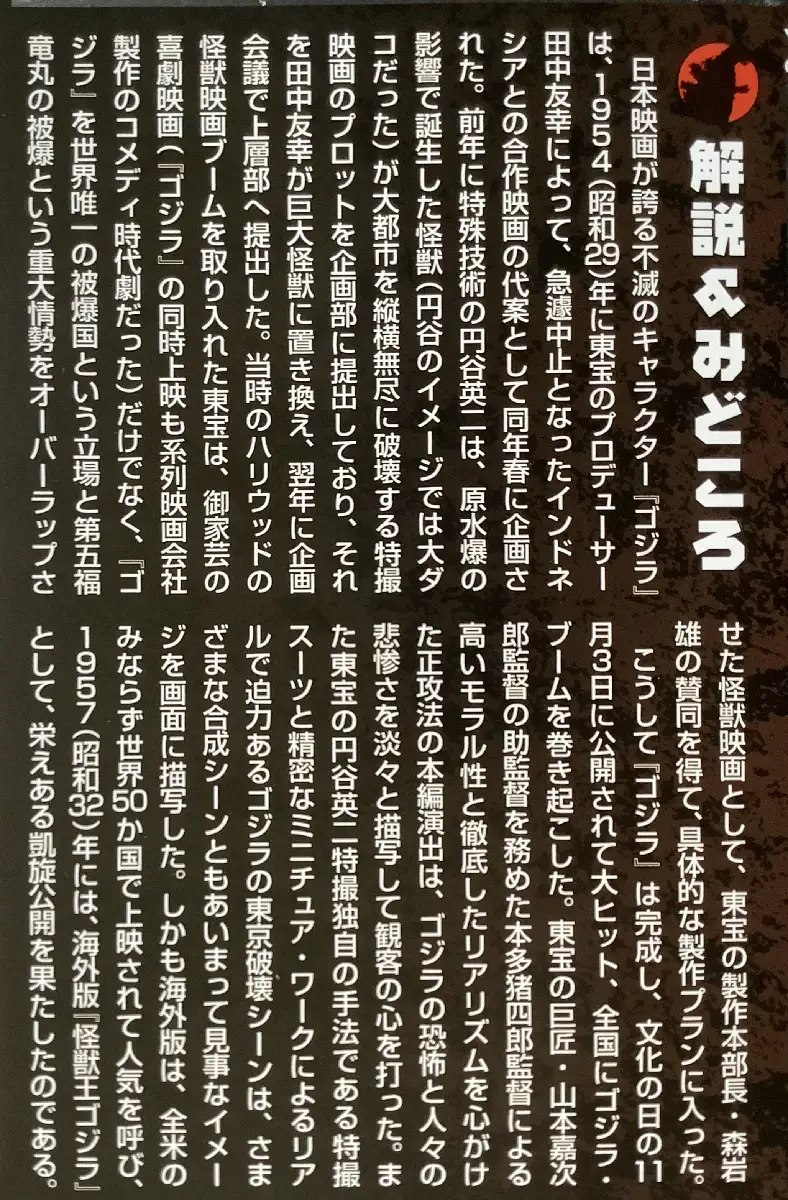8.14.2023
Godzilla 1954 Highlights

解説&みどころ
Explanation & highlights
日本映画が誇る不滅のキャラクター「ゴジラ』は、1954(昭和2)年に東宝のプロデューサー田中友幸によって、急遽中止となったインドネシアとの合作映画の代案として同年春に企画された。前年に特殊技術の円谷英二は、原水爆の影響で誕生した怪獣(円谷のイメージでは大ダコだった)が大都市を縦横無尽に破壊する特撮映画のプロットを企画部に提出しており、それを田中友幸が巨大怪獣に置き換え、翌年に企画会議で上層部へ提出した。当時のハリウッドの怪獣映画ブームを取り入れた東宝は、御家芸の喜劇映画(『ゴジラ』の同時上映も系列映画会社製作のコメディ時代劇だった)だけでなく、「ゴジラ』を世界唯一の被爆国という立場と第五福竜丸の被爆という重大情勢をオーバーラップさせた怪獣映画として、東宝の製作本部長・森岩雄の賛同を得て、具体的な製作プランに入った。
Godzilla, the immortal character that Japanese cinema is proud of, was planned in the spring of 1954 by Toho producer Tomoyuki Tanaka as an alternative to the abruptly canceled joint production with Indonesia. In the previous year, Eiji Tsuburaya, who specializes in technology, submitted to the planning department the plot of a special effects movie in which a monster (in Tsuburaya’s image, was a giant octopus) born from the effects of an atomic and hydrogen bomb destroyed a large city. Tomoyuki Tanaka replaced it with a giant monster and submitted it to the upper management at a planning meeting the following year. Toho, which adopted the monster movie boom in Hollywood at the time, produced not only comedy films of his specialty (the simultaneous screening of “Godzilla” was also a comedy period drama produced by an affiliated film company), but also “Godzilla,” which was the only country in the world to have suffered an atomic bombing. With the approval of Iwao Mori, head of Toho’s production division, we entered into a concrete production plan as a monster movie that overlaps the situation of the Daigo Fukuryu Maru being bombed.
こうして「ゴジラ」は完成し、文化の日の11月3日に公開されて大ヒット、全国にゴジラ・ブームを巻き起こした。東宝の巨匠・山本嘉次郎監督の助監督を務めた本多猪四郎監督による高いモラル性と徹底したリアリズムを心がけ正攻法の本編演出は、ゴジラの恐怖と人々の悲惨さを淡々と描写して観客の心を打った。また東宝の円谷英二特撮独自の手法である特撮スーツと精密なミニチュア・ワークによるリアルで迫力あるゴジラの東京破壊シーンは、さまざまな合成シーンともあいまって見事なイメージを画面に描写した。しかも海外版は、全米のみならず世界50か国で上映されて人気を呼び、1957(昭和32)年には、海外版「怪獣王ゴジラ」として、栄えある凱旋公開を果たしたのである。
In this way, “Godzilla” was completed and released on November 3rd, the day of culture, and became a big hit, causing a nationwide Godzilla boom. Director Ishiro Honda, who served as assistant director to Toho’s master Kajiro Yamamoto, directed the main story with high morality and thorough realism in mind. It hit me. In addition, Toho Eiji Tsuburaya’s unique special effects special effects suit and precise miniature work create a realistic and powerful Godzilla destruction scene in Tokyo. Moreover, the overseas version was screened not only in the United States but also in 50 countries around the world, gaining popularity, and in 1957 (Showa 32), the overseas version “Godzilla, the King of Monsters” made a triumphant return to the public.
Source: 東宝特撮映画DVDコレクション1ゴジラ, p 5